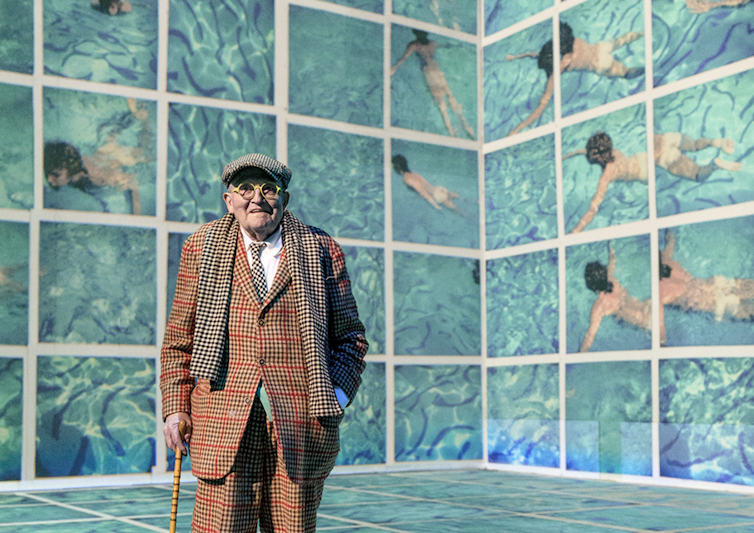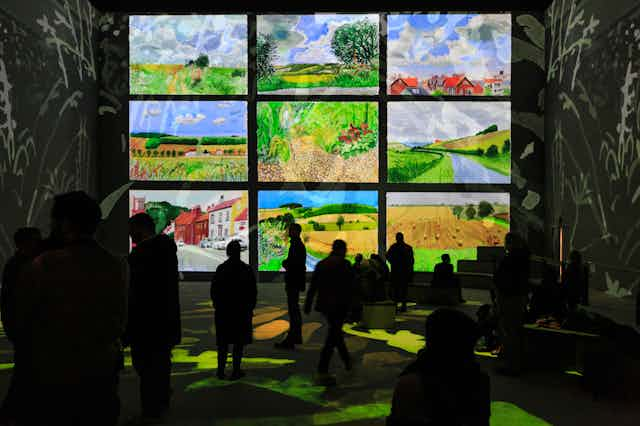Artist David Hockney has ridden many technological waves. While his mark-making has remained resolutely painterly, he has challenged the practice of painting. He was an early adopter of computer-assisted drawing, using the iPad and iPhone.
His latest work, Bigger and Closer (not smaller and further away), at Lightroom in London is an ambitious exhibition and another foray into the future from the 85-year-old artist. Using multiple large-scale video displays, Hockney has decided to stage an immersive exhibition that reviews the last 60 years of his work.
His is not the first – there have been immersive exhibitions of Van Gogh, Salvador Dalí, Frida Kahlo and Gustav Klimt. However, Hockney is one of the first mainstream and, crucially, still-living artists to take on this format.
There have been many critics of immersive exhibitions who see them as commercial ploys built for the Instagram age, not for “serious” lovers of art. Hockney is defying these naysayers.
Like his adoption of the iPad and other tech, he is acknowledging our digitally-dominated world. Consumers increasingly desire cutting-edge and unique “experiences”, and Hockney is delivering experiential value beyond basic function – beyond the experience of static paintings.
Deconstruction
What I’ve always liked about Hockney’s work is his deconstructive approach. He takes things apart and reconstitutes them, for us to see them all the better.
Take, for instance, his innovative photographic desert landscape collage, PearBlossom Highway. This work appears to have been exploded, deconstructed and reassembled in an effort to demand our attention. This is 1980s photographic technology stretched and experimented with. “Look and notice what I see (as the driver or passenger) passing through this immense US landscape,” he seems to say.
As a researcher, he also considered how painting may have significantly altered using early camera obscura. Known as the “Hockney-Falco thesis”, he explains technology is an aid to the making process and one to be embraced and experimented with across his diverse range of art-making. Why use outdated techniques, he argues.

The question now is whether Hockney can successfully deconstruct and reconfigure his large body of work to construct a meaningful, enjoyable and even exciting audience experience.
The art world has offered mixed reactions to the act of repurposing artists’ work for immersive exhibitions. Many would say that works are being altered beyond recognition through the process of post-production and animation. Sometimes this happens in bizarre ways, as art critic Ben Davis argues regarding Van Gogh’s Cafe Terrace at Night transformed into a split curtain blowing in the wind, or Skull of a Skeleton with Burning Cigarette puffing smoke.
While these installations are modernistic, utilising commercial event techniques, the exploitation of artistic intellectual property is nothing new. Original art has long been shifted sideways into the museum shop, and repurposed as domestic items such as cups and saucers and shoulder bags. Should we be sniffy about this, and the further exploitation of artworks into the realm of video installation?
What’s different about Hockney’s exhibition from those before is that, as a living artist, he can control his own technology and vision. Hockney has had a huge hand in how this hour-long performance looks and sounds.
In a cycle of six-themed chapters, the artist reveals his process to visitors. His works dance about the walls in a carefully choreographed spectacle – accompanied by a specially composed soundtrack by the American composer Nico Muhly and the voice of the artist himself.
Immersive art is not new
Digital artists such as Jeffrey Shaw have experimented over many years with a myriad of digital technologies. Legible City (1989) transforms the act of cycling through a city into an interactive, immersive act of reading as three-dimensional words and sentences replace the architecture of the streets of Amsterdam.
In this immersive art piece, Shaw exposed the difficulties of engaging an audience. This early work made plain that artists cannot simply hide behind a technical facade, but must still work to entice their audiences. Legible City is now visually and technically dated, but holds its own as a concept.
Virtual reality, augmented reality and projection mapping are all useful tools. But lacking conceptual design, their use can quickly become dated. How do you keep an audience on a journey beyond the initial thrill and technical surprise?
While technological considerations may initially lead, staging considerations must soon take precedence. Is it enough to present a simplistic art history timeline of one image after the other? Probably not.
Good immersive exhibitions will explore and create emotion. They will use thrill, fear, humour and cheek to propel people through a narrative, however nonlinear the journey may be.
During the late 1960s, the artist Edward Kienholz created a complex installation reflecting racism in the US. Titled Five Car Stud, the work is still highly relevant. Audiences walk around a harrowing dark and highly detailed film-like set replete with vehicles, trees and plaster-cast humans as a racist murder takes place. It’s a shocking experience.
Can Hockney’s immersive exhibition succeed beyond the most basic idea of presenting his own art history on a big scale? My hope is that it does, and that this installation attracts a wider audience to contemporary art. This is Hockney’s desire too: “I hope it gives young people some ideas,” he said.
The 85-year-old artist embraces the digital future more than many who are half his age. I am intrigued to see what he takes on next.
Bigger & Closer (not smaller & further away) is at Lightroom in London from February 22 until June 4 2023.

